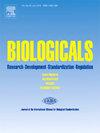Validation of a Next Generation Sequencing Method for adventitious agents detection in a live vaccine matrix
IF 1.5
4区 生物学
Q4 BIOCHEMICAL RESEARCH METHODS
引用次数: 0
Abstract
Next Generation Sequencing (NGS) has proven itself as a suitable replacement technology for traditional viral safety assessment assays in the manufacturing of complex biologics. Most notably, its incorporation into ICH Q5A(R2) in November 2023 endorses the technology platform as a suitable alternative to traditional in vivo, in vitro and PCR-based testing for adventitious viruses based on the risk assessment of the product and its context for use. In addition to the finalization of ICH Q5A(R2), a separate European Pharmacopoeia chapter Ph. Eur. 2.6.41 (High Throughput Sequencing for the Detection of Viral Extraneous Agents) is under review to further outline and provide guidance for the application and validation of NGS-based methodologies. Within the context of avian-based quadrivalent influenza vaccine manufacturing, NGS provides an alternative viral safety assessment method to traditional in vivo based testing models which are requirements for every lot manufactured. However, prior to implementation of NGS alternative methodology for commercial product testing, suitability of the method must be demonstrated within the context of the product through appropriate assay validation.
In line with ICHQ5A (R2), 3.2.5.2 Next Generation Sequencing, non-targeted NGS can replace In vivo with broad virus detection for unknown or unexpected virus species without a head-to-head comparison. Therefore, complying with ICH Q5A (R2) and also AstraZeneca internal risk assessment for adventitious agents’ detection, a comparability study directly comparing In vivo to NGS was not completed.
This article summarizes the collaborative effort between AstraZeneca and MilliporeSigma to replace the in vivo adventitious virus test for Live Attenuated Influenza Vaccine (LAIV) with NGS for broad virus detection as part of a comprehensive virus testing strategy.
在活疫苗基质中检测不定因子的新一代测序方法的验证
新一代测序技术(NGS)已被证明是复杂生物制剂生产中传统病毒安全性评估分析的合适替代技术。最值得注意的是,该技术平台于2023年11月被纳入ICH Q5A(R2),根据产品的风险评估及其使用环境,认可该技术平台作为传统的体外、体内和基于pcr的外源病毒检测的合适替代方案。除了ICH Q5A(R2)的定稿外,正在审查单独的欧洲药典章节Ph. Eur. 2.6.41(用于检测病毒外源剂的高通量测序),以进一步概述和指导基于ngs的方法的应用和验证。在以禽类为基础的四价流感疫苗生产的背景下,NGS提供了一种替代传统的基于体内的测试模型的病毒安全性评估方法,这是每批生产的要求。然而,在实施NGS替代方法用于商业产品测试之前,必须通过适当的分析验证来证明该方法在产品环境中的适用性。根据ICHQ5A (R2), 3.2.5.2 Next Generation Sequencing,非靶向NGS可以替代In - vivo,对未知或意外的病毒种进行广泛的病毒检测,而无需进行头对头比较。因此,根据ICH Q5A (R2)和阿斯利康内部风险评估对外来药物的检测,没有完成直接比较In vivo和NGS的可比性研究。本文总结了阿斯利康和MilliporeSigma之间的合作努力,用NGS取代流感减毒活疫苗(LAIV)的体内不定病毒检测,作为全面病毒检测策略的一部分。
本文章由计算机程序翻译,如有差异,请以英文原文为准。
求助全文
约1分钟内获得全文
求助全文
来源期刊

Biologicals
生物-生化研究方法
CiteScore
3.70
自引率
0.00%
发文量
39
审稿时长
48 days
期刊介绍:
Biologicals provides a modern and multidisciplinary international forum for news, debate, and original research on all aspects of biologicals used in human and veterinary medicine. The journal publishes original papers, reviews, and letters relevant to the development, production, quality control, and standardization of biological derived from both novel and established biotechnologies. Special issues are produced to reflect topics of particular international interest and concern.Three types of papers are welcome: original research reports, short papers, and review articles. The journal will also publish comments and letters to the editor, book reviews, meeting reports and information on regulatory issues.
 求助内容:
求助内容: 应助结果提醒方式:
应助结果提醒方式:


